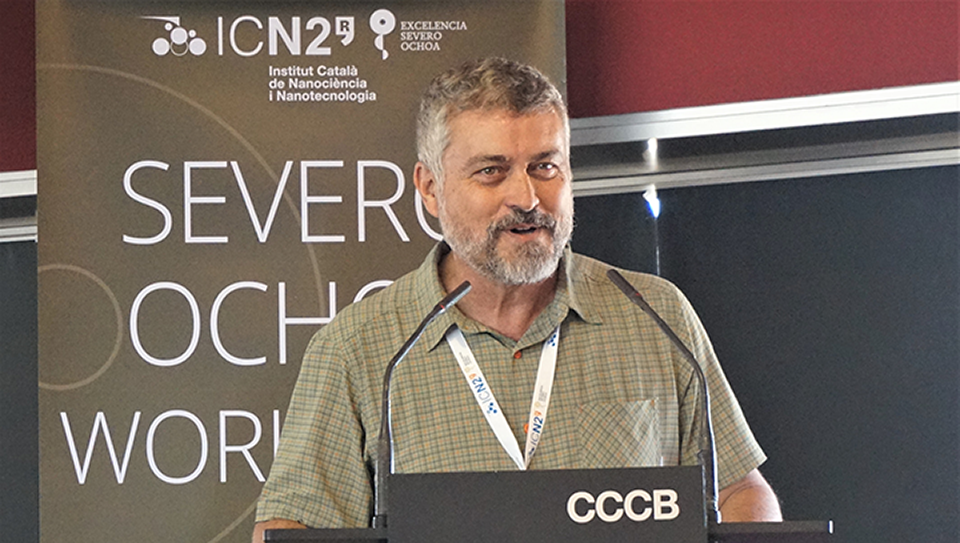The first Severo Ochoa Workshop on Energy Storage and Harvesting organized by the ICN2 took place at the Contemporary Culture Centre of Barcelona (CCCB) on July 12. Experts on clean energy technologies based on nanomaterials and nanodevices were invited to share the results of their research and to discuss the future of this field.

On July 12, the ICN2 held the “Energy Mining in the 21st Century” Workshop at the Contemporary Culture Centre of Barcelona (CCCB). It was the first of two Severo Ochoa events on Energy Storage and Harvesting organized by the ICN2, within the framework of the 2018-2022 Excelencia Severo Ochoa Programme, with the aim of facilitating the dialogue and the establishment of new international collaborations between research groups working on clean energy technologies based on nanomaterials and nanodevices.
Against the backdrop of the Barcelona skyline, visible from the large windows of the “Mirador” room of the CCCB, recognized researchers from various European institutes and from the ICN2 animated a fruitful discussion on the new challenges that our society is facing in terms of energy production and management. By presenting the studies carried out at their laboratories, they traced an overview of the technologies involving materials and structures at the nanoscale which are currently under development to address these needs. Representatives of selected local companies operating in the field participated in the workshop as well, to contribute the industrial point of view in vision of future technology transfer collaborations.
The workshop was opened by ICN2 Director Prof. Pablo Ordejón, who highlighted the objectives of the Severo Ochoa Programme, and by Prof. Pedro Gomez, leader of the ICN2 Novel Energy-Oriented Materials group, who set the scene for the discussion. Dr Raúl Benagues, from the same ICN2 group, chaired the whole event. Articulated in three sessions, the workshop focused on harvesting of clean energy, its storage, the integration of the two processes on a same device, and innovative approaches to renewable energy.
The first part of the discussion was dedicated to the harvesting of the various sources of clean energy that surround us, from ambient vibration and body movement all the way to the Sun. While currently most of this energy goes wasted, in the last decades an increasing effort has been put in developing technologies to take advantage of these sources and nanotechnologies are being explored for these applications. Dr Sohini Kar-Narayan, from the University of Cambridge (UK), provided an overview of her group’s studies on nanostructures of piezoelectric and triboelectric materials, which have the property of accumulating electric charge in response respectively to applied mechanical stress (piezoelectricity) or to friction (triboelectricity). Dr João O. Ventura, from the University of Porto (Portugal), followed with a report on triboelectric nanogenerators and their application as novel energy harvesters in harsh environments (i.e., extreme temperature and pressure conditions).
The second session was devoted to photovoltaic energy. Prof. Anders Hagfeldt, from the Ecole Polytechnique Federale de Lausanne (EPFL, Switzerland), described the versatility of mesoscopic solar cells, presenting the recent work of his group on solid-state dye-sensitized solar cells and perovskite solar cells. Then, Dr Mariano Campoy Quiles, from the Institute of Materials Science of Barcelona (ICMAB-CSIC, Spain) reported on some technologies that, by fine-tuning the solar cells structure, allow optimizing their performance to the specific application (from colour-on-demand solar cells to thermoelectric generators). The crucial topic of battery exhaustion was then introduced by Dr Geoffroy Gosset, CEO and Co-founder of E-Peas, a Belgian company dedicated to the development and production of batteries for wireless devices, which can last much longer than the common ones by harvesting ambient energy.
Storage was the focus of the third session, opened by Dr María Escudero Escribano, from the University of Copenhagen (Denmark), who presented the work she is carrying out with her group on tailored electrocatalysts for renewable energy conversion and production of sustainable fuels. Dr Teresa Andreu followed on the stage, discussing her studies on conversion of carbon dioxide and water into carbo-neutral synthetic fuels and their practical implementation on a large scale. Finally, possible alternatives to actual battery technologies based on critical raw material were discussed by Dr Christophe Aucher, from the LEITAT Technology Centre (Spain).
Without the ambition to fully cover the extremely broad panorama of research in the field of energy harvesting and storage, this workshop offered an opportunity for reflection and debate about cutting-edge technologies on which the energy production system of the future will be based. Hopefully, it also fueled new and more extended collaborations between various excellent research groups around Europe, with the aim of accelerating this ongoing energy revolution.

